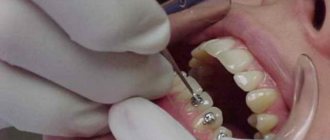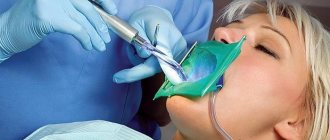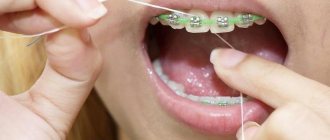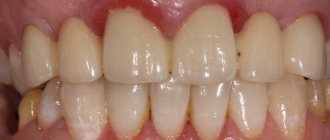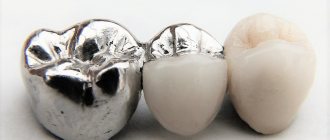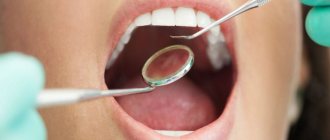Indications Preparation Materials Installation Doctors Work
Many patients are faced with the need to restore teeth using prosthetics. And, of course, they are interested in how a crown is placed on a tooth, what material it is made of, which is better, what are the stages of making crowns and whether it hurts. First of all, understanding the process gives the patient confidence in the face of the unknown. Although, he and the doctor know one thing for sure - after a crown is installed on a tooth, aesthetics and functionality return. And that means self-confidence.
Dentistry characterizes the term “crown” as follows: it is a prosthesis placed on a tooth or implant, and may be part of a bridge or other prosthesis. In this case, the crowns are attached to the base, the arch of the structure, simulating missing elements.
They are made from various materials that have proven themselves in dental practice.
In what cases is it necessary to use this type of prosthetics?
Indications for crown installation
- A severely damaged tooth, more than 50%
, when a filling cannot restore it. The cause is most often advanced caries; - large chip due to injury. In this case, the root is intact. It is enough to put a crown on top to restore integrity;
- fluorosis A disease that manifests itself as stains on teeth that cannot be whitened. Appear from an excess of fluoride in the body;
- aesthetic restoration, in case of defects: curvatures, altered shape, dissatisfaction with the color of the enamel.
Survey
Diagnostics helps to accurately assess the condition of teeth, gums, and facial bones and determine the optimal method of treating edentulism. To do this, the dentist:
- Interviews the patient and listens to complaints.
- Examines all organs of the oral cavity - teeth, gums, tongue.
- Prescribes radiography or CT (computed tomography).
The images help determine whether the teeth adjacent to the defect are suitable for use as supports. Sometimes, after radiography, it also turns out that adjacent units are not suitable for adjacent implants or bridges.
Preparation for prosthetic crowns
Before any prosthetics, an examination of the oral cavity is required at the initial appointment. The condition of the teeth, roots, and periodontium is assessed. And before a crown is placed, the patient and the doctor go through several stages:
- Tooth preparation
. Cleansing the cavity from carious tissue. If necessary, depulpation and filling of canals. - Turning
(preparation) for the crown. This is necessary for a tight fit between the edges of the tooth and the prosthesis. The enamel is removed to the thickness of the crown. When choosing cast ones, less fabric is removed; metal-ceramic, ceramic - more. On average, about 2.5 mm. The result is a stump that looks like a stump, and a crown is attached to it. - Sometimes it is necessary to strengthen the root of a tooth
. In this case, a stump tab is first placed. Its pins are installed in the root canal, and the upper part of the stump is used to fix the crown. - When installing a crown on implants, the implant is implanted into the prepared hole, and a prosthetic crown is placed on the upper part.
- Taking an impression
, an impression using a plastic mass to model the dentition from plaster, which is necessary for the further work of the technician. - Making a crown
in a dental laboratory.
Important!
Treatment of the tooth on which the crown will be installed must be at a high level: all diseased tissues are removed, the nerve canals are completely cleaned and sealed correctly. It is important. Since if there is pain under the crown due to missed caries or others, it will be necessary to remove the entire structure and begin treatment and installation again.
SURGICAL STAGE
- Removal of untreatable and dead teeth and roots;
- Removal of existing exostoses and osteophytes that interfere with the installation of the prosthesis;
- Removal of soft gum tissues subject to hypertrophy and other areas of the mucous membrane;
- Intervention to deepen the vestibule of the oral cavity, plastic surgery of the tongue, frenulum, upper or lower lip - if necessary;
- Installation of implants for fixed dental prosthetics and to create support for removable denture structures;
- Performing osteoplasty - building or removing bone tissue;
- Carrying out a sinus lift in the upper jaw to raise the bottom of its sinus. This is necessary to create space for a dental implant.
The surgical stage requires recovery of the body for about 2 months before prosthetics.
How to make a crown on a tooth
After the plaster model of the dentition is ready, the technician in the dental laboratory, depending on the selected material of the future prosthesis, decides how the crown is made: from a single piece of zirconium, by milling, by casting, etc.
Crowns are made from the following materials
:
- Made of metal
. Cobalt-chrome or noble - alloys of gold, silver, palladium, titanium. They can withstand heavy loads and are durable, but such crowns are attached to distant teeth to hide them from the smile area; - ceramics (porcelain)
is often chosen for the front teeth due to its high aesthetics and similarity to natural color and tone; - metal ceramics
do a good job of solving the problems of chewing teeth, coping with the load; - zirconium
is the optimal option for reliability and aesthetics. It is increasingly recommended in clinics as a modern approach to prosthetics; - plastic ones
are installed temporarily while permanent crowns are being made.
A - metal, B - metal ceramics, C - zirconium, D - metal-plastic
Solid crowns are cast from metal. Therefore, they are very strong and have a long service life.
Metal-ceramic - based on metal with layer-by-layer coating of ceramics on top.
For zirconium, an automated CAD/CAM
, with minimal human factor. Computer 3D modeling of a model of the future prosthesis is loaded into a program that, in a special block, controls a milling cutter and makes the necessary prosthesis from zirconium dioxide. The most accurate crowns made from this material.
Ceramic ones are made from pressed E-max ceramics or by milling a single piece of ceramic using CAD/CAM technology. Standard production is possible - baking in an oven.
What is a dental crown
A crown is a type of dental prosthesis, non-removable, completely or partially covering the visible part of the tooth. Sometimes it is part of a larger prosthesis, such as a bridge. Crowns are distinguished:
- orthopedic. Replenish the missing part of the tooth crown. These include equatorial, three-quarter (for premolars), half-crowns (protect part of the vertical surface and the cutting edge);
- full clinical. Like a cap, they cover the entire stump of the tooth.
- stump, fenestrated, crowns with a pin are placed when more than 80% of tooth decay occurs, so they are often classified as pin structures.
To ensure that the crown does not interfere with the closure and active movement of the jaw, it is made according to the shape of the tooth, with a tight coverage of the neck without immersing more than 0.2 mm in the gum pocket. “Parts” for this type of fixed prosthetics are cast from metals, alloys, porcelain, and plastic. There are combined dentures, when a material different from the base is used for lining.
An inlay is first installed under the crown. Happens:
- straight (direct), made in the mouth, used when the tooth has 3 out of 4 walls left. Externally, it is a screw or pin that is inserted into the canal with a filling;
- indirect (indirect), an impression is made, and the inlay is cast from it in the laboratory.
The pin cult inlay is considered more reliable (and expensive); a ceramic inlay is placed under ceramic dentures.
Dental crown
Color selection
Based on the color of neighboring teeth, antagonists and characteristics: shade, brightness, intensity, the required tone for the future crown is selected. It will be uneven, like a natural one. The neck has one undertone, the cutting edge has a slightly different one. By mixing different numbers of colors of ceramic powder, the technician achieves the desired result.
The Vita scale is used in dental practice
, where red, brown, yellow, gray lead the groups, and the tones of each of them are indicated by numbers. 1 - the lightest tone and then darker in increasing order.
Lighting in the office is no less important when determining the color of future artificial teeth. All these points are always taken into account by experienced specialists.
ORTHODONTIC STAGE
At this stage, if necessary, the following problems can be corrected:
- Forms of dentition;
- Positions of abutment teeth;
- Inclination of teeth in relation to missing teeth;
- Fan-shaped position of teeth;
- Pulling out impacted teeth that can become a support for a denture.
During the orthodontic stage, the specialist focuses on secondary deformations of the remaining teeth, if the patient’s neighboring teeth or antagonist teeth were previously removed. Preparation for prosthetics at this stage takes from 2-3 months to 2-3 years.
Is it possible to install a crown without pulp removal?
This question is the second most popular one asked to a dentist. First, does it hurt when a crown is placed on a tooth? Let's start with the fact that the crown is installed painlessly
. All stages of the crown installation procedure are performed under local anesthesia, or the treatment can be performed while you sleep.
Is it possible to keep a tooth “alive”
under the crown, the doctor decides after examination and x-ray diagnostics. If the root is healthy and there is more than one, then it is not necessary to perform pulp removal. After turning it, you can put a crown on it. Every dentist knows that a tooth with a removed nerve becomes fragile and more vulnerable to aggressive external factors. In any situation, the possibility of saving the tooth is always considered.
Knowing about all the stages of crown installation and manufacturing, it is much easier for the patient to take the first step towards restoring teeth using prosthetics.
Expert of the article Alekperov Roman Borisovich Dentist-orthopedist, doctor of the first category
Work experience24 years
Which crown is better to put?
Based on the materials used, the following types of crowns are distinguished.
Sitall
Crowns made of glass-crystalline materials are biologically inert, i.e. do not cause adverse clinical manifestations. Dentures resist the chewing load well, are quite elastic, and have increased resistance to the corrosive effects of aggressive agents. The main disadvantage is fragility. Recommended for allergy sufferers and chronically ill people (due to the consumption of a large number of medications, they should avoid anything that can provoke an allergy or cause a rejection reaction).
Porcelain (ceramics)
Standard porcelain “caps” are made with a stably fixed or separate metal pin (the second option is more convenient). A more expensive option is custom-made prostheses based on a platinum matrix. After 2 annealings, a stage of shape correction between them, the individual characteristics of the teeth (cracks, stains) are imitated on the surface. Then they are tinted with majolica glazes, securing with another annealing. Then the “cap” will look natural.
Porcelain crowns
The main disadvantages of porcelain fixed dentures:
- fragility;
- poor marginal fit;
- abrade the surface of antagonist teeth.
They are chosen by people who have high aesthetic requirements for the oral cavity (show business). Ceramic dentures are also used for those who cannot undergo restoration with a composite. If the occlusal load is distributed unevenly, the dentist will suggest a different material.
Metal
More than 500 alloys are used in dentistry, but most metal fixed dentures are made of chromium-nickel or silver-palladium alloy, as well as 900 gold with the addition of copper, silver, and platinum as a ligature.
Metal “caps” are resistant to alkali and acid (in small concentrations), have high wear resistance, are moderately elastic, and are relatively biologically indifferent. The fashion for the “gold tooth” is back. Metal prostheses are durable products that do not require special attention. The retention time of the properties of a metal crown depends on the alloy.
Zirconium dioxide
These are the most popular of all fixed types of prostheses. Zirconium oxide (or dioxide, in the formula there are 2 oxygen molecules per molecule of zirconium) is chosen by public figures. The process of making a “cap” is labor-intensive, using computer modeling, so the product is expensive. This is a category of elite prosthetics.
The crown is durable, its color and transparency are very similar to a real tooth. In terms of all the characteristics of medical implants (bioinertness, resistance to acid-base influence, elasticity) it is one of the best.
There are 2 types of crowns:
- with the application of ceramics, when metal is used as a base;
- without porcelain, then the desired shade is manually applied to it.
Advantages of zirconium fixed prostheses:
- Making fairly thin crowns with minimal grinding (this way the teeth remain alive).
- Accuracy of fit (computer modeling is used).
- The service life of crowns is from 10 to 20 years.
- High aesthetics. In terms of transparency and structure, they best match natural teeth.
- Strength. They are made for both front and chewing teeth.
- Biocompatibility.
- High precision in the manufacture of crowns allows you to achieve the tightest possible fit, avoiding the inflammatory process and the development of caries.
Metal ceramics
This is a good alternative to porcelain crowns, since metal-ceramic prostheses are characterized by:
- increased strength;
- better fit at the edges.
Metal ceramics
A metal alloy is used for the base, and a ceramic mass is applied to it. The best base is gold, in which case the base is thin, freeing up more space for ceramics. The metal will not show through the porcelain - this makes your smile look more natural. But there is a nuance: it is highly undesirable to install several fixed dentures (or a base with ceramics) made of different metals. For installation, deep preparation is used only on the vestibular surface (this is the side of the tooth turned towards the lips and cheeks) to mask the frame of the prosthesis.
Contraindications for installation:
- Teeth with thin crowns, when there is a risk of pulp damage.
- Deep blocking or wearing away bite.
- Pathological abrasion of tooth tissues.
- Parafunctions of the masticatory muscles, in which there is high muscle excitability, bruxism, and lateral displacement of the jaw.
Please note: it is better to avoid metal-ceramic crowns if you have marginal periodontal diseases, because Patients regularly experience functional overload of teeth, which leads to exacerbation of inflammation and deepening of the destruction process.
Metal-plastic
The second name for “caps” is combined, because Composed of plastic, composite, porcelain. These are temporary “caps” since the service life usually does not exceed 3 years. Plastic deteriorates over time under the influence of acids and alkalis, and can be colored with natural food dyes (wine). Summary: not bad, as a temporary option (there are situations, for example, injury, accident, but tomorrow you need to speak, be at negotiations).
Plastic
With good aesthetic properties, a plastic fixed prosthesis is inferior to its analogues in strength. It is not used to restore thin or flat incisors, with a deep or receding bite, pathological abrasion of teeth, or some dentition defects. This type of crown should not be placed on people with allergies.
Fixed dentures are made in 2-3 layers on an interpenetrating polymer mesh. They are recommended for prosthetics for children, during the correction of dentoalveolar anomalies, during periods of primary and mixed dentition.
Temporary crowns made of plastic
When, in addition to turning, is an inlay or pin additionally installed?
After grinding the teeth, a metal-ceramic, ceramic or metal crown can be placed immediately, provided that the destruction of the prosthetic tooth is not too extensive. Otherwise, after finishing the turning, an inlay is placed in the tooth, which will increase the adhesion area with the crown and make the structure more durable. Here and there you can still find mention of pins used for the same purposes. However, progressive dentists consider this technique to be ineffective and associated with a number of complications, so today its use has practically been abandoned.
Installation of prostheses
When the crowns or dental bridges are ready, the final stage of prosthetics will begin. Installation of structures is carried out in accordance with the chosen method. If removable dentures are performed, the doctor shows the patient how to properly put on and remove the structure from the mouth. A specialist fixes permanent crowns and bridges in such a way that they are securely held on the supporting elements. There is no need to remove such dentures yourself; they remain in the oral cavity permanently.
Before installation, fittings are carried out to show whether adjustment (correction) of the structure is required. After the patient approves the prosthesis, the dentist performs its final fixation.
How painful is the procedure?
The procedure is unpleasant psychologically, but the preparation will be carried out only after the doctor gives you anesthesia - the anesthetic is given even when the grinding is minimal or when the tooth is already “dead”, i.e. it lacks a nerve. This will help you feel absolutely no pain or discomfort in the dentist’s chair. True, some patients, after the effect of anesthesia wears off, note the occurrence of pain reactions. In most cases, pain occurs when a sufficiently large layer of tissue is removed, i.e. before prosthetics with crowns or bridges. Then this is a natural phenomenon that is associated with interference in the living tissues of the body. After all, during the preparation, the doctor used a drill, which heated the tissue and pushed back the gum in order to create a ledge.
The unpleasant sensations should pass soon, but if they continue to bother you for more than 3-5 days and increase in intensity, then be sure to see a doctor. Perhaps the specialist made mistakes when grinding hard tissues, which resulted in an inflammatory process.
Features of the event
Before grinding teeth, X-ray diagnostics are performed to clarify their structure, identify possible hidden pathologies and determine places where the thickness of the dental tissues is the smallest, which means there is a possibility of opening the pulp chamber during preparation. If the procedure is performed on living teeth, local anesthesia is performed. On previously pulpless teeth, preparation does not require anesthesia, but many patients still ask for it to be done so as not to experience discomfort.
Today, dentists carry out several types of dental tissue preparation, differing in the tools and technology used:
- Tunnel grinding of teeth . It is carried out using a turbine medical unit (bur) with steel or diamond tips of the working tool. This installation makes it possible to regulate the speed of the procedure, and during preparation the doctor tries to remove as little of his own dental tissue as possible. The main advantage of the method is the ability to fully control the depth of preparation and complete predictability of the result obtained.
- Ultrasonic preparation . The procedure is carried out using high-frequency ultrasonic vibration of the working tool. In this case, the dental tissues do not heat up, the pressure on them is minimal, there are no microcracks or chips in the enamel, and the pulp tissues are not affected in any way.
- Laser preparation . The procedure is carried out using a pulsed laser, under the influence of which the desired layer of enamel and dentin is removed. The procedure is completely safe, silent, atraumatic, and completely eliminates the possibility of infection and the formation of chips and cracks.
- Chemical method . The dental tissue is softened using an active chemical (usually acids) and then removed. There is no heating of dental tissues, chips or microcracks.
- Air abrasive method . An air-powder mixture is used here, which is supplied under high pressure. Abrasive particles of powder remove the desired layer of hard tissue, and tooth dust is immediately removed from the oral cavity.
When choosing a technique, the doctor is usually guided by a number of factors: the clinical situation, the condition of the oral cavity as a whole, the wishes of the patient and the capabilities of the clinic.
